- Bernard Preston homepage
- Starch
- Corn Flour Milling Machine
Corn flour milling machine
A corn flour milling machine could use rollers, hammers or stones to grind the grain. One of the chief aims is to keep the temperature down.
Traditionally of course stone grinders were driven by very slow water-wheels and windmills; little heat was generated.
Or the grain was ground by hand; in Zulu to "gaya" using a stone mortar and pestle.
These days most industrial grinding of maize is done using a roller or hammer-mill.
Corn: That which sustains life
Corn is the second most abundant cereal grain crop in the world, second only to rice. In India it is known as "the grain which sustains life."
Unrefined it is an excellent source of energy, many vitamins and important phytonutrients; and minerals too. As such it is the premier animal feed.
Alas for humans where mouth feel is all-important, the fibre, germ and bran are extracted and most of the goodness with them. What remains is highly glycaemic, contributing to the obesity and type-2 pandemics.
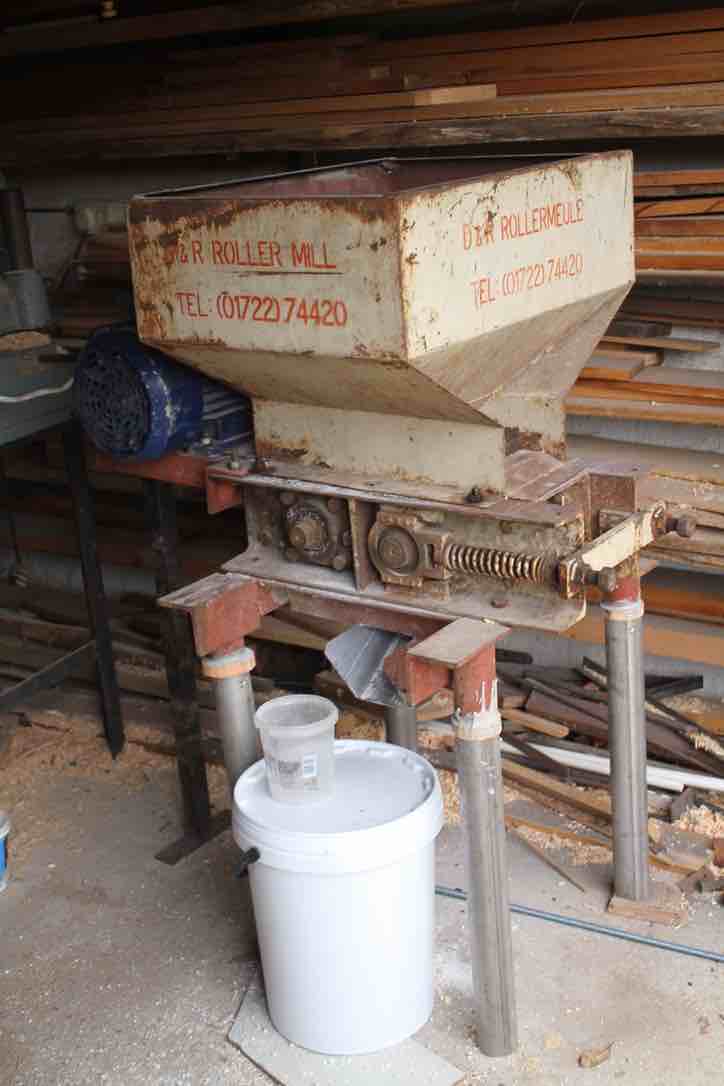
This old roller mill is used mainly for chicken feed but also for the first phase before the maize goes into a small stone grinder.
The aim is to produce "straight-run," whole cornflour where there is no separation of the bran, germ and meal; in exactly the same ratio as in the grain. The full complement of protein, fat and starch is retained; the vitamins, minerals and phytonutrients too.
The grooved steel rollers flake off the bran and germ while the starch is cracked into coarse pieces.
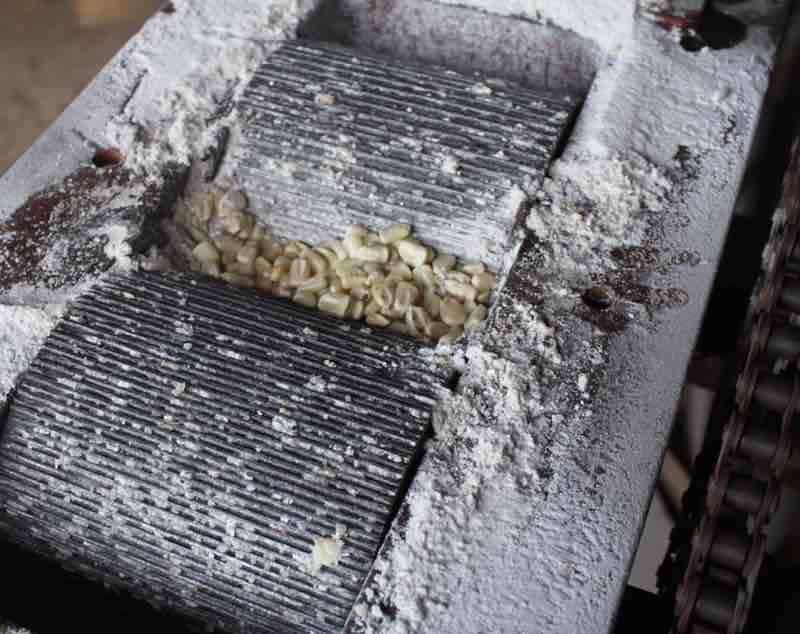
Normally this corn flour milling machine would be powered by a 3-phase electric motor but a single will do provided all the grain is completely ground so that none remains between the rollers, as above at the end of the operation; then it will not start.
For human consumption thereafter the half-ground corn goes to this little stone mill which produces fine 100% wholemeal containing all the bran and germ; and the full complement of vitamins, minerals and antioxidants.
A small corn flour milling machine
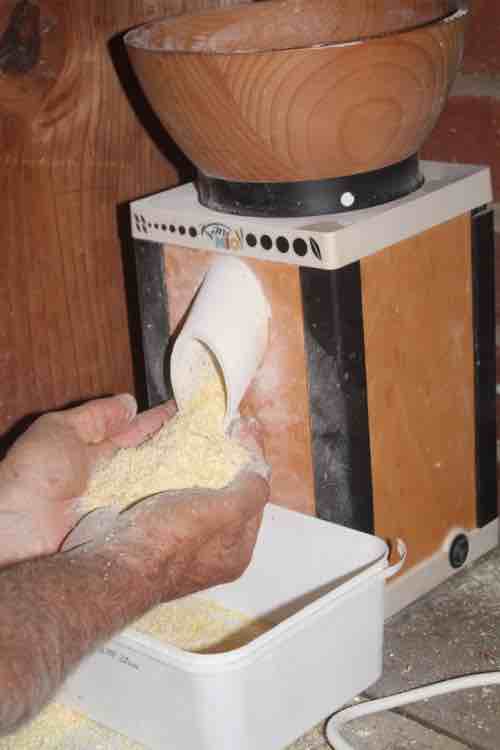
The oil in corn flour is the reason that millers refine the grain, extracting the fat; that and there is a greater profit margin selling the best part, the "hominy chop" to the pig farmers.
So the millers remove the oils which begin to go rancid once the grain is cracked. Freshly-ground wholemeal should be consumed within a week; longer if refrigerated or frozen.
Stone mills driven by electric motors generate a lot of heat; it's a good idea to freeze the grain before grinding.
"Mostly the nutrient concentration is higher in the outer part of the grain; so differential milling or refining results in reduced mineral, vitamin and phytochemical content except the starch[3]."
Hominy chop
Hominy chop contains most of the protein and fat. Millers contend that it's what is left after the best part, the starch, has been taken out for human consumption.
This is a contentious point; farmers would claim that the germ and bran are in fact the best parts. Without them the cornmeal is highly glycemic and fattening; for both humans and animals.
The bran contains the fibre which is known to stimulate the growth of beneficial bacteria, the microbiome, in the colon. However it is considered a byproduct and most of it goes to animal feed[2].
Cholesterol and melanomas
Scientists have also shown that the oil in corn bran lowers the total blood cholesterol levels by a massive 29%[2].
Phenols in corn bran also have anti-diabetic properties and give protection to the skin against the noxious effect of excessive exposure to sunlight. Those who enjoy a porridge from a corn flour milling machine are far less likely to suffer from a melanoma.
If you're not yet convinced, read more at this next page.
Essential fatty acids
There are two "essential" fatty acids that we absolutely must get from our food; our bodies cannot synthesize them. We cannot be healthy without them.
- ALA which is alpha linolenic acid (only 1% of corn oil)
- Linoleic acid (abundant in corn oil)
Germ oil in corn flour
The germ in corn is double that in other grains, about 5%[2] but would be removed by modern corn flour milling machines, if the three fractions are split as is customary.
The oil makes up about half of the germ.
- Linoleic acid 56%
- Oleic acid 29%
Linoleic acid is an essential fat; deprived of it children will be stunted mentally.
Oleic acid is not an essential lipid but it is the premier monounsaturated fat that makes olives and avocados so healthy.
These are poly and mono-unsaturated fats; there is no cholesterol. True wholegrain cornmeal is extremely healthy.
The majority of the tocols are found in the oil-rich germ layer; and as this part in corn is larger, its concentration is also higher.
Degerming and milling remove over 90% of the vitamin E content[4]; and the essential linoleic acid.
Antioxidants in corn flour
The details are not important as it is complex biochemistry but the bran contains phenols and ferulic acid which are potent antioxidants; they are released in the colon which is constantly under attack because of all the fecal material making it prone to aggressive malignant tumours.
This ferulic acid found in the bran also exhibits antimicrobial activity against pathogens in the colon.
All these benefits are lost when a corn flour milling machine is used that separates the bran from the rest of the kernel; it is usually discarded and finds its way into animal feed.
"In the process of refining grain, the bran is separated, resulting in the loss of dietary fiber, vitamins and minerals; lignans, phytoestrogens, and phenolic compounds too."
- Oghbaei and Prakash [3]
Malignant breast tumours
The bran of grains also contains lignans which have a potent anti-tumour effect against malignant neoplasms in the breast and prostate gland. They too are lost in the modern refining of corn.
Considering modern milling techniques that extract the lignans, ferulic acid and vitamin E, it comes as no surprise that malignant tumours of the breast, prostate and colon are steadily increasing.
Phytosterols in corn flour
Phytosterols found in the bran have a structure similar to animal cholesterol; they compete with LDLs for absorption in the small intestine making us less prone to the toxic lipoproteins in the blood requiring medication like statins.
One of these phytonutrients in the bran is gamma-tocopherol, an isomers of vitamin E that gives protection against malignant prostate tumours.
They too are lost if the corn flour milling machine refines out the bran; making us prone to raised cholesterol, statin-prescription and neoplasms in the nether parts.
- "Most vitamins and minerals (45%) are found in the germ and bran portion of grains. Milling of grains results in major losses of thiamine, biotin and vitamin B6; folic acid, riboflavin and niacin too.
- There are also substantial losses of calcium, iron and magnesium.
- 75% of the original vitamins are lost when grains are milled.
- 25% of the protein is lost."[3]
Vitamins in corn flour
Milling and subsequent refining by extraction of the bran and germ results in substantial loss of the vitamin content.
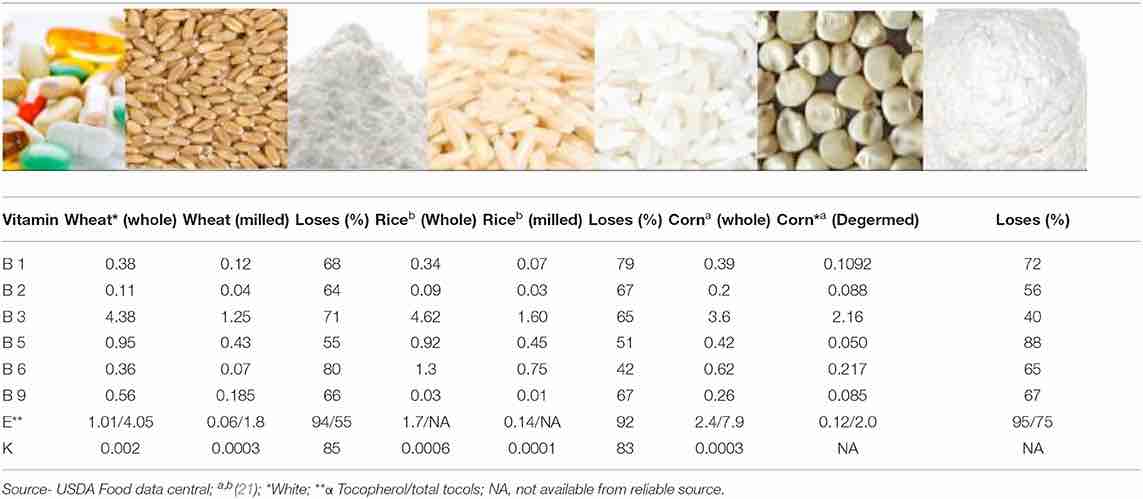
Take home
The take home in all of this is that the bran and germ of corn have many important biological functions in the body. They should certainly not be considered byproducts and used primarily as animal feed. We humans also desperately need maizemeal, as it is known in South Africa that is unrefined.
We look forward to corn flour milling machines in villages and towns that produce freshly-ground "straight run" maizemeal for the general populace. Lower rates of obesity and diabetes are anticipated; and less malignant tumours of the breast, prostate and colon.
"Recent studies show the beneficial effect of phytic acid, the content of which is high in cereal bran. It is effective in prevention of coronary disease and has anticarcinogenic properties."[3]
Corn flour milling machine
A local corn flour milling machine is the only way to obtain freshly-ground porridge for home use; it must be consumed within a week or two. The small Mio above will do the job but it is recommended to pass the mealies through twice, the first to grind the grain coarsely followed by a finer setting.
“There is no man living that cannot do more than he thinks he can.”
- Henry Ford
Isigayo milling machine
This modern milling machine is relatively inexpensive; there is no separation of the three streams. The important nutrients, protein and fat are not lost; those found in the bran and germ.
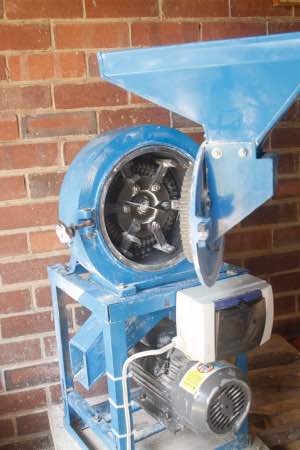 Isigayo, the Zulu name for a maize mill.
Isigayo, the Zulu name for a maize mill.The "isigayo" will produce a third of a ton of high quality maizemeal per day; it uses single-phase electricity. However it must have a "D curve" circuit breaker for a switch; the inrush current is very high. If you look carefully you will see there are two large capacitors.
It's recommended you drive this mill with an inverter less than 15kW; the inrush current is too great.
The porridge is very tasty, particularly when made using yellow corn.
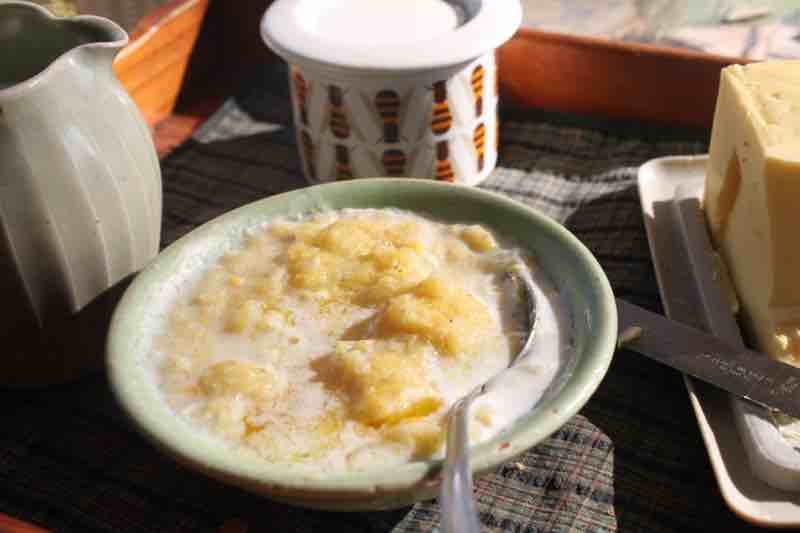 Yellow maizemeal has more protein and less glycemic starch
Yellow maizemeal has more protein and less glycemic starchStrong research confirms that obese people turning to true whole grains will slowly lose weight; but less than 1 percent of American children and 8% of adults eat the recommended dietary allowance[5]. South Africa is not likely to be much different.
Super refined white maizemeal is one of the chief causes of type-2 diabetes in Southern Africa; yellow has less starch and is rich in beta carotene.
"Research shows that true whole-grains foods are associated with a decreased risk of heart disease, stroke and type 2 diabetes."
- Diabetes Canada
- Restoring the Community Grain Mill in the Appalachia Mountains
- The healthy components in corn bran
- Effect of primary processing of cereals and legumes on its nutritional quality. Web: https://www.tandfonline.com/doi/full/10.1080/23311932.2015.1136015
- Vitamins in Cereals: A Critical Review of Content, Health Effects and Processing Losses
- Whole grain consumption trends and associations with body weight
When browsing use right click and "Open Link in New Tab" or you may get a bad gateway signal.
Newsletter
Our newsletter is entitled "create a cyan zone" at your home, preserving both yourself and Mother Earth for future generations; and the family too, of course. We promise not to spam you with daily emails promoting various products. You may get an occasional nudge to buy one of my books.
Here are the back issues.
- Lifestyle and ideal body weight
- What are ultra-processed foods?
- Investing in long-term health
- Diseases from plastic exposure
- Intensive lifestyle management for obesity has limited value
- A world largely devoid of Parkinson's Disease
- The impact of friendly bacteria in the tum on the prevention of cancer
- There's a hole in the bucket
- Everyone is talking about weight loss drugs
- Pull the sweet tooth
- If you suffer from heartburn plant a susu
- Refined maize meal and stunting
- Should agriculture and industry get priority for water and electricity?
- Nature is calling
- Mill your own flour
- Bake your own sourdough bread
- Microplastics from our water
- Alternative types of water storage
- Wear your clothes out
- Comfort foods
- Create a bee-friendly environment
- Go to bed slightly hungry
- Keep bees
- Blue zone folk are religious
- Reduce plastic waste
- Family is important
- What can go in compost?
- Grow broad beans for longevity
- Harvest and store sunshine
- Blue zone exercise
- Harvest and store your rainwater
- Create a cyan zone at your home
Did you find this page interesting? How about forwarding it to a friendly book or food junkie? Better still, a social media tick would help.
- Bernard Preston homepage
- Starch
- Corn Flour Milling Machine
Address:
56 Groenekloof Rd,
Hilton, KZN
South Africa
Website:
https://www.bernard-preston.com